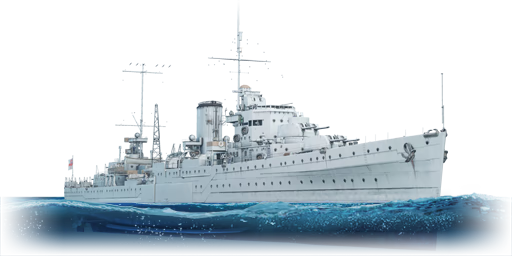The HMNZS Leander was the lead ship of the Leander-class light cruisers built for the Royal Navy in the early 1930s, mainly designed for commerce protection based on experience with the York-class heavy cruisers. The HMNZS Leander was laid down on 8th September 1930, commissioned on 24th March 1933, and assigned to the New Zealand Division of the Royal Navy. In 1941, the New Zealand Division became the Royal New Zealand Navy and Leander's prefix changed from HMS to HMNZS. Leander initially served in the Pacific and Indian Oceans, where she sank Italian and Vichy France merchantmen. On 22nd April 1941, Leander took part in the search for German commerce raider Pinguin which was later sunk by HMS Cornwall. Between June and September 1941, Leander was transferred to the Mediterranean before returning to the Pacific. On 13th July 1943, Leander, together with US Navy Brooklyn-class light cruisers USS St. Louis, USS Wichita, and a group of ten destroyers, took part in the Battle of Kolombangara. At 01:00, radar contact was made with Japanese light cruiser Jintsuu and five destroyers. In the ensuing battle, Jintsuu was sunk and all three Allied cruisers were hit by Japanese Long Lance torpedoes. Leander was struck with a single torpedo in the boiler room, and the damage caused was so extensive that she spent the rest of the war being repaired. After repairs in Auckland, she went to Boston for a refit, and returned to the Royal Navy on 27th August 1945. Leander took part in the Corfu Channel Incident in 1946. She was decommissioned in February 1948 and sold for scrap in 1950.
Introduced in Update 1.87 "Locked On", HMS Leander is armed with the same fast-firing 6-inch cannons as the preceding Arethusa, though with an extra main turret alongside significantly lighter anti-aircraft defences. Leander also features a thicker main armour belt around the machinery, 76 mm thick instead of the 57 mm on Arethusa. The elevators and turrets are both protected by all-around 25 mm thick armour, and the bridge features 12 mm anti-fragmentation armour, providing at least some degree of protection from HE shells. However, all the boiler rooms can be disabled with a single hit due to them not being separated. Magazines are quite deep under the waterline, making the ship quite protected from fatal explosion if hit. The Leander is also equipped with two quadruple torpedo launchers on each side of the hull, however while the torpedoes have a good speed of 74 km/h, they have only 4.57 km range, making their use very situational.















